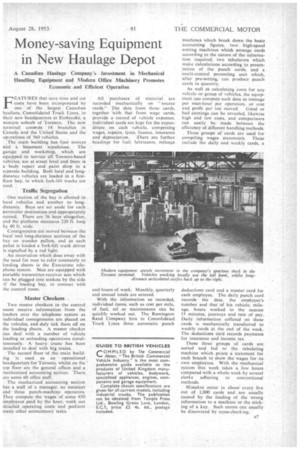Money-saving Equipment in New Haulage Depot
Page 41

If you've noticed an error in this article please click here to report it so we can fix it.
A Canadian Haulage Company's Investment its Mechanical Handling Equipment and Modern Office Machinery Promotes Economic .and Efficient Operation FEATURES EATURES that save time and cut costs have been incorporated by one of the largest Canadian hauliers, Consolidated Truck Lines, in their new headquarters at Etobicoke, a western suburb of Toronto. The new terminal controls 14 branches in Canada and the United States and the operations of 560 vehicles.
The main building has four storeys and a basement warehouse. The garage and workshop, which are equipped to 'service all Toronto-based vehicles, are at street level and there is a body repair and paint shop in a separate building. Both local and longdistance vehicles are loaded in a firstfloor bay, in which fork-lift trucks are used.
Traffic Segregation
One section of the bay is allotted to local vehicles and another to longdistance. Bays are set aside for each particular destination and appropriately named. There are 36 bays altogether, and the platform measures 220 ft. long by 40 ft. wide.
Consignments are moved between the local And long-distance sections of the bay on wooden pallets, and as each pallet is loaded a fork-lift truck driver is signalled by a red light.
An innovation which does away with the need for men to refer constantly to loading sheets is the Executone telephone system. Men arc equipped with portable transmitter-receiver sets which can be plugged into sockets by the side af the loading bay, to connect with the control room.
Master Checkers.
Two master checkers in the control room receive information from the loaders over the telephone system as individual consignments are placed on the vehicles, and duly tick them off on the loading sheets. A master checker can deal with a number of vehicle loading or unloading operations simultaneously. A heavy crane has been installed to deal with big crates.
The second floor of the main building is used as an operational headquarters for Toronto, whilst on the top floor are the general offices and a mechanized accounting section. There are some 60 office staff.
The mechanized accounting section has a staff of a manager, an assistant and three punch-machine operators. They compute the wages•of some 450 employees paid by the hour, work out detailed operating costs and perform many other accountancy tasks.
All purchases of material are recorded mechanically on "source cards." The data from these cards, together with that from wage cards, provide a record of vehicle expenses. individual cards are kept for the expenditure on each vehicle, comprising wages. repairs, tyres, licence, insurance and depreciation. :There arc further headings for fuel. lubricants, mileage .
and hours of work. Monthly, quarterly and annual totals are entered.
With the information so recorded, individual items, such as cost per mile, of fuel, oil or maintenance can be quickly worked out. The Remington Rand Company hire to Consolidated Truck Lines three automatic punch machines which break down the basic accounting figures, two high-speed sorting machines which arrange cards according to the nature of the information required, two tabulators which make calculations according to presentation of the punch cards, and a multi-control presenting unit which, after pre-setting, can produce punch cards in quantity.
As well as calculating costs for any vehicle or group of vehicles, the equipment can compute such data as tonnage per man-hour per operation, or cost and profit per ton moved: Good or bad earnings can be revealed, likewise high and low costs, and comparisons can easily be made between the efficiency of different handling methods.
Three groups of cards are used for compiling wages statements. These include the daily and weekly cards, a deductions card and a master card for each employee. The daily punch card records the date, the employee's number and that of his vehicle, mileage, hours worked to the nearest 15 minutes, journeys and rate of pay. Daily information collated on these cards is mechanically transferred to weekly cards at the end of the week. The deductions card records payments for insurance and income tax.
These three groups of cards are sorted and fed to the tabulating machine which prints a statement for each branch to show the wages for its own employees. With the mechanical system this work takes a few hours compared with a whole week by several clerks adhering to conventional methods.
Mistakes occur in about every five out of 1,000 cards and are usually caused by the feeding of the wrong information to a machine or the sticking of a key. Such errors can usually be discovered by cross-checking.




















































































